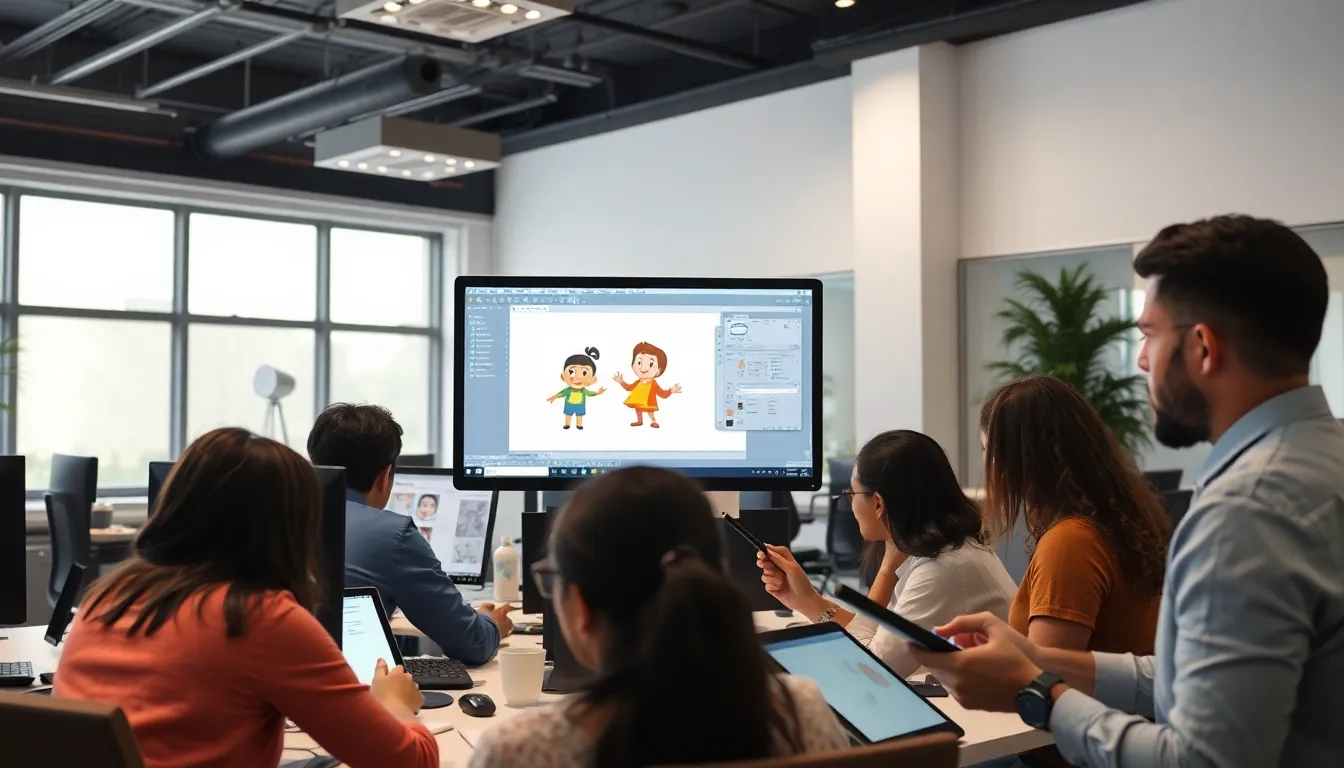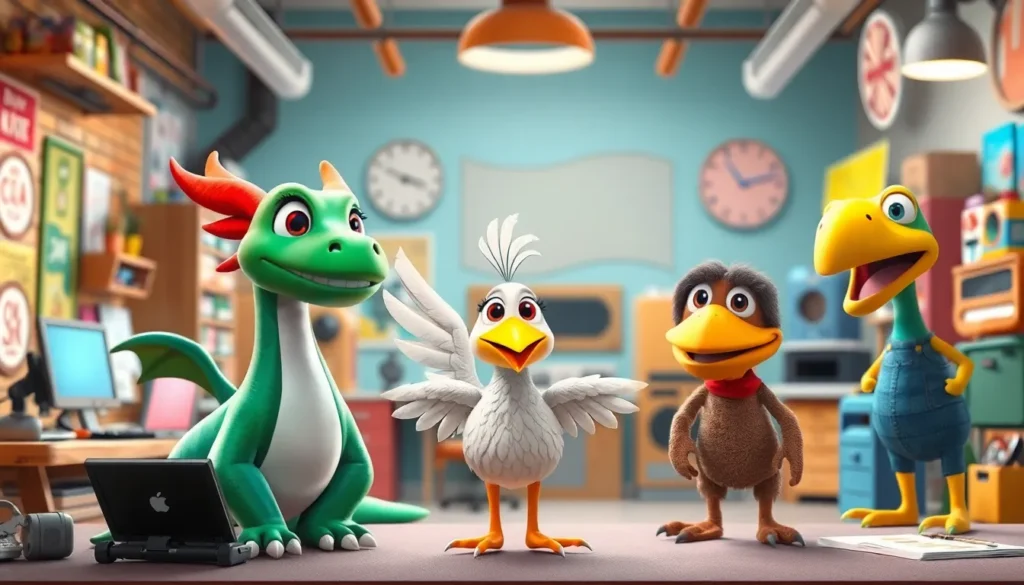Table of Contents
ToggleIn a world where attention spans are shorter than a cat video, animation has emerged as the superhero of storytelling. It captivates audiences, brings ideas to life, and transforms mundane concepts into visual feasts. Whether it’s for marketing, education, or just plain fun, creating animation can elevate any message from “meh” to “wow!” Today, anyone can create animation easily with the help of user-friendly tools, making it possible to share stories that are as engaging as they are memorable.”
Understanding Animation Basics
Animation serves as a powerful tool for storytelling, captivating audiences and enhancing communication. By exploring animation fundamentals, creators can effectively convey messages through engaging visuals.
Types of Animation
Various types of animation exist, each bringing unique characteristics. Traditional animation uses hand-drawn images, while 2D animation follows software-based techniques to create movement. 3D animation delivers lifelike visuals, commonly seen in films and video games. Stop-motion animation employs physical objects, making them appear animated frame by frame. Last, computer-generated imagery, or CGI, integrates digital models, enhancing visual storytelling.
Key Terms in Animation
Several key terms define the animation landscape. Frame refers to each individual image in a sequence. Keyframes signify important frames that define motion, while interpolation fills in the gaps between them. Timing describes movement speed and rhythm in animation. Animation principles, such as squash and stretch, guide the creation of believable, dynamic movements. Understanding these terms aids in mastering the animation process and improving overall quality.
Tools and Software to Create Animation

Animation creation relies on specific tools and software that cater to various needs and skill levels. Both free and paid options exist, allowing flexibility for beginners and professionals.
Free Animation Software
Several free animation software options are available for creators seeking budget-friendly solutions. Blender offers robust features for 3D modeling and animation, appealing to artists with a strong interest in CGI. Krita excels in 2D animation and painting, perfect for illustrators developing animated projects. Pencil2D provides an intuitive interface for traditional animation by allowing frame-by-frame work. OpenToonz, used in professional studios, supports a wide range of animation techniques and workflows. Animaker allows users to create animated videos quickly, featuring a user-friendly drag-and-drop interface. Each software option empowers creators to explore animation without financial constraints.
Paid Animation Software
Investing in paid animation software can significantly enhance productivity and access to advanced features. Adobe Animate stands out for its comprehensive tools tailored for 2D animation and interactivity, suited for web and mobile applications. Toon Boom Harmony is the industry standard for professional animators, offering a wide array of features for traditional and digital animation. Maya by Autodesk remains the leading choice for 3D animation and modeling, known for its powerful capabilities used in film and gaming. Cinema 4D provides stunning results in motion graphics and visual effects, ideal for designers focused on 3D animation. Moho Pro combines 2D animation with powerful rigging capabilities, making it a favorite among character animators. Investing in these software solutions often results in superior animation quality and efficiency.
Step-by-Step Guide to Create Animation
Creating animation requires careful planning and execution. Follow these steps to bring your ideas to life.
Planning Your Animation
Define objectives and target audience before starting. Storyboarding helps visualize scenes and sequence. Develop characters and environments by sketching concepts that represent your vision. Determine the style of animation, selecting from 2D, 3D, or stop-motion based on your project needs. Establish a timeline and budget to guide the production process. Don’t overlook the importance of gathering feedback during the planning stage to refine ideas.
Creating Your First Animation
Begin by selecting the right software for your skill level. Start with a simple animation project to familiarize yourself with tools like Blender or Krita. Import your storyboard and character designs into the software. Create keyframes to define significant points in the animation. Use interpolation methods to generate movement between keyframes. Keep an eye on timing and pacing to ensure smooth transitions. Test animations frequently, making adjustments as needed for quality. Finally, export your animation in the desired format for sharing or presentation.
Tips for Effective Animation
Effective animation relies on thoughtful planning and execution. Prioritizing key steps enhances the overall quality and engagement of the final product.
Storyboarding and Scripting
Creating a storyboard serves as the blueprint for the animation project. Each scene should illustrate key actions, character movements, and transitions. Writing a script complements the storyboard by detailing dialogue and narration. Both tools ensure clear communication of ideas and objectives. Visualizing the story aids in identifying pacing and flow, allowing creators to refine their vision before diving into production.
Timing and Framing
Timing plays a crucial role in animation, influencing how audiences perceive movement and emotion. Each frame must align with the intended rhythm, creating a natural progression. Establishing appropriate frame rates enhances fluidity and maintains viewer interest. Adjusting the timing of actions, such as quick gestures or slow expressions, adds depth to characters. Directors can elevate storytelling by using creative framing techniques, highlighting important elements, and guiding viewer focus effectively.
Animation’s role in storytelling continues to evolve and expand. Its ability to transform ideas into engaging visual narratives makes it an essential tool across various fields. By mastering the fundamentals and utilizing the right software, creators can bring their visions to life with clarity and impact.
With thoughtful planning and execution animators can enhance the quality and effectiveness of their work. Whether for marketing education or entertainment the power of animation is undeniable. Embracing this art form opens doors to endless possibilities for creative expression and audience engagement.




